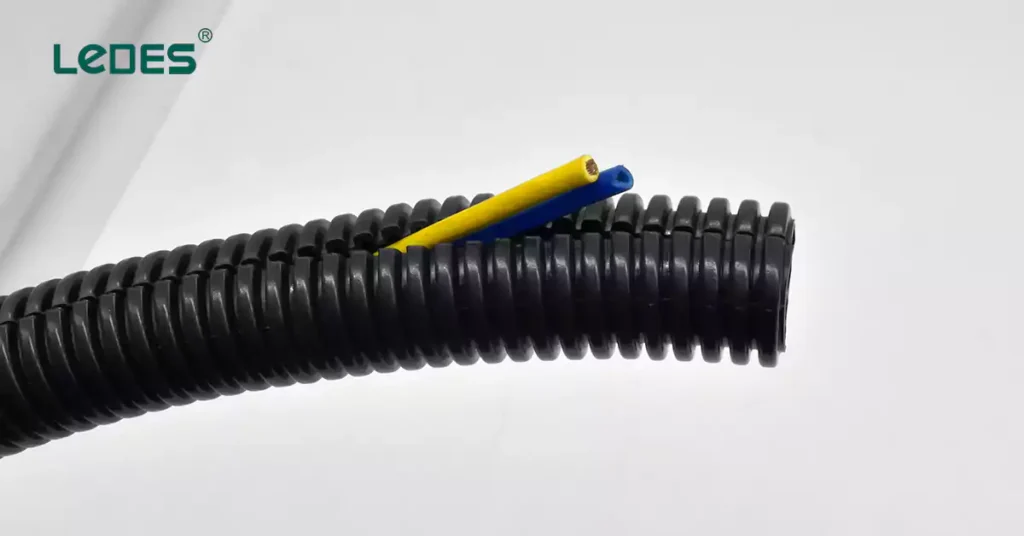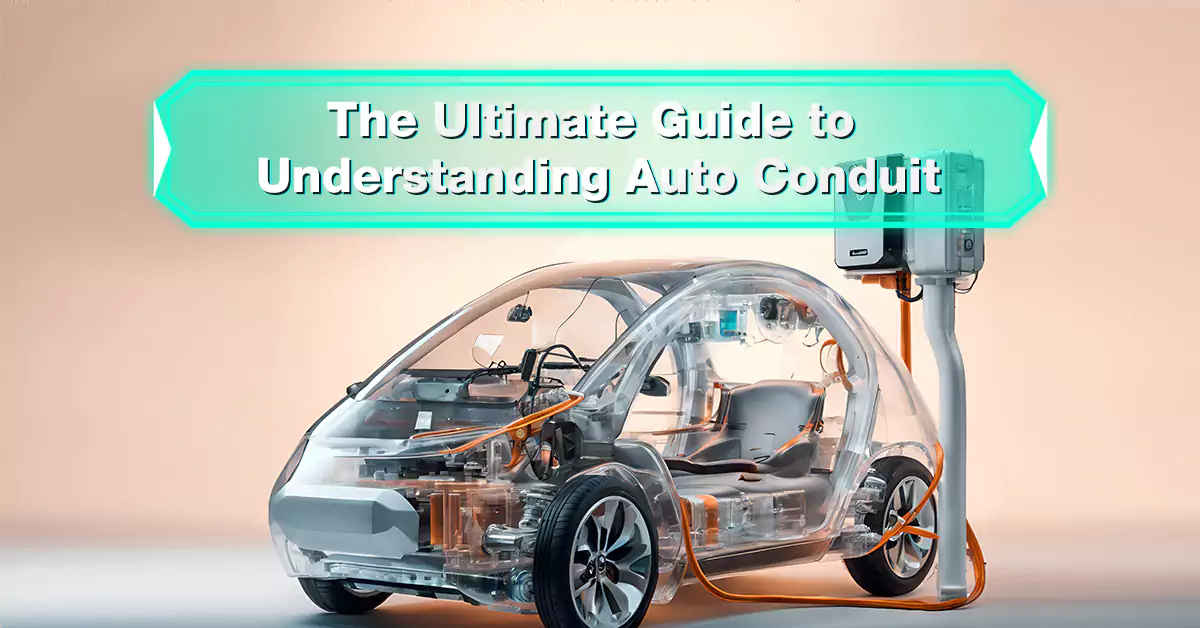
Índice
Com o rápido desenvolvimento da indústria de veículos elétricos, o auto conduíte gradualmente entrou em nossa visão. Como um fornecedor tradicional de conduítes de cabos, sabemos que, embora os conduítes de plástico pareçam discretos, eles são muito importantes.
Neste post, discutiremos o conteúdo relevante sobre conduítes elétricos automotivos em detalhes. Ao ler, você pode aprender:
O que é Auto Conduit e como ele funciona?
Por que o eletroduto automotivo é importante para sistemas elétricos?
Como escolher o tamanho certo para o eletroduto automotivo?
E mais. Então, vamos começar.
Um conduíte automotivo é um tubo usado para proteger e rotear a fiação elétrica em um veículo. Os conduítes automotivos podem ser feitos de metal ou plástico. A maioria dos conduítes é flexível bipartida, mas o conduíte rígido é usado para alguns propósitos.
Conduítes automotivos e conduítes elétricos de PVC são projetados para atender aos rigorosos requisitos de desempenho da indústria automotiva. Eles protegem os fios internos de impactos, bactérias, produtos químicos e outras formas de corrosão, particularmente nas condições exigentes do compartimento do motor.
Como todos sabemos, os veículos elétricos geralmente têm altas tensões, então, quando os fios internos se rompem e causam um curto-circuito ou alta tensão instantânea, isso pode causar riscos potenciais ao carro, ao motorista e aos passageiros.
Os conduítes elétricos automotivos não são simplesmente tubos para transportar fios elétricos. Eles agem como caminhos de proteção, canalizando eletricidade de forma segura e eficiente, ao mesmo tempo em que protegem contra uma infinidade de perigos potenciais. Pense neles como as artérias do sistema circulatório de um carro elétrico, garantindo que a energia vital chegue ao seu destino sem interrupção ou perigo.
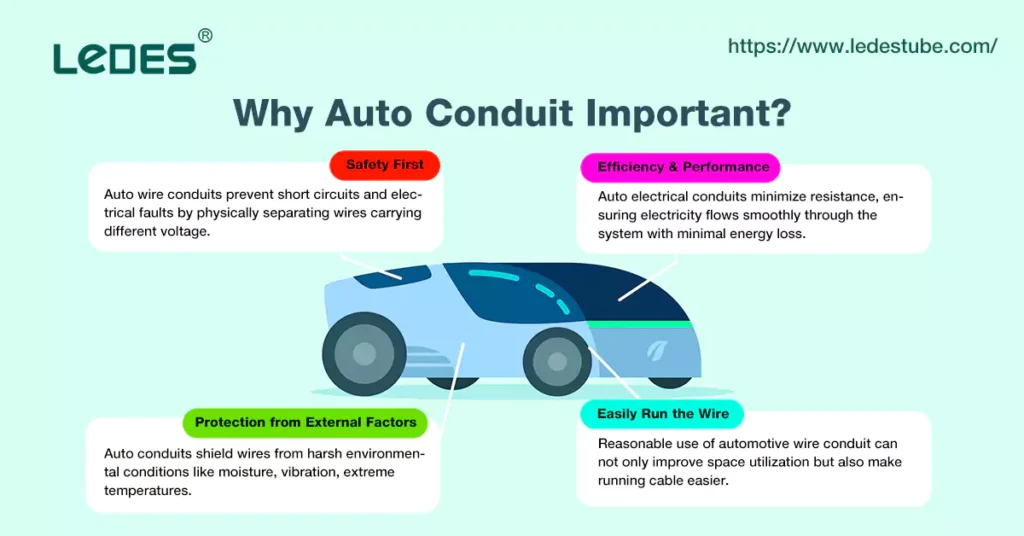
Segurança em primeiro lugar: Os conduítes de fiação automotiva evitam curtos-circuitos e falhas elétricas ao separar fisicamente os fios que transportam diferentes voltagens, reduzindo o risco de superaquecimento, incêndios e ferimentos. Um relatório de 2022 da National Highway Traffic Safety Administration (NHTSA) destacou que a fiação defeituosa foi um fator contribuinte em quase 10% de recalls de veículos relacionados a sistemas elétricos.
Eficiência e Desempenho: Auto elétrica conduits minimizam a resistência, garantindo que a eletricidade flua suavemente pelo sistema com perda mínima de energia. Isso se traduz em melhor desempenho e alcance para EVs, onde cada watt conta.
Proteção contra fatores externos: Os conduítes automotivos protegem os fios de condições ambientais adversas, como umidade, vibração, temperaturas extremas e até mesmo detritos corrosivos da estrada. Essa durabilidade é essencial para a longevidade e manutenção do desempenho elétrico confiável ao longo do tempo.
Passe o fio facilmente. O espaço interno de veículos de nova energia é compacto, especialmente o compartimento do motor ou a carroceria. O uso razoável de conduítes de fios automotivos pode não apenas melhorar a utilização do espaço, mas também facilitar a passagem de cabos. Mesmo se houver reparo ou manutenção, é fácil adicionar ou remover cabos, deixar os fios mais bonitos e evitar riscos potenciais.
Após um incidente de incêndio de alto perfil envolvendo um Tesla Model 3 em 2019, investigações revelaram que o incêndio se originou de um módulo de bateria sob o piso, potencialmente exacerbado por isolamento de fiação defeituoso. Este caso ressalta a importância crítica de conduítes robustos para conter e mitigar potenciais riscos elétricos dentro de EVs.
“Conduítes não são apenas conduítes passivos; eles contribuem ativamente para a segurança, desempenho e confiabilidade dos veículos elétricos”, afirma a Dra. Emily Chen, especialista em eletrificação automotiva da Society of Automotive Engineers (SAE). “Os materiais usados e os princípios de design empregados no desenvolvimento de conduítes automotivos são cruciais para garantir um futuro seguro e eficiente de mobilidade.”
À medida que os VEs se tornam cada vez mais complexos, espere ver conduítes ainda mais sofisticados com:
Sensores integrados: Para monitoramento em tempo real e avaliação de condições.
Blindagem EMI: Para proteger sistemas eletrônicos sensíveis contra interferência eletromagnética.
Materiais leves: Contribuir para a redução geral do peso do veículo.
O futuro dos conduítes automotivos está interligado ao futuro dos veículos elétricos. Investir em pesquisa e desenvolvimento nessa área será crucial para impulsionar a inovação, aumentar a segurança e garantir uma transição perfeita para um cenário de transporte mais sustentável.
Selecionar o tamanho correto do conduíte automotivo não se trata apenas de espremer fios em um cano; trata-se de garantir fornecimento de energia eficiente, desempenho ideal e, acima de tudo, segurança.
Um conduíte mal dimensionado pode causar superaquecimento, redução na transferência de energia ou até mesmo riscos de incêndio — consequências que nenhum proprietário de veículo deseja enfrentar.
O dimensionamento do conduíte automático depende de vários fatores principais:
Consumo atual: A quantidade de corrente elétrica fluindo pelos fios determina o tamanho necessário do conduíte. Correntes mais altas exigem conduítes maiores para evitar acúmulo excessivo de calor e manter temperaturas operacionais seguras.
Calibre do fio: Quanto mais grosso (calibre menor) for o fio, mais corrente ele pode suportar, influenciando o diâmetro necessário do conduíte.
Número de fios: Vários fios agrupados dentro de um conduíte aumentam seus requisitos de volume interno. A superlotação leva a problemas de dissipação de calor e fluxo de ar reduzido.
Condições ambientais: Temperaturas extremas ou exposição a elementos agressivos exigem conduítes maiores para acomodar a potencial expansão/contração dos fios e evitar a degradação do isolamento.
O tamanho comum do tubo elétrico automotivo é de 9 mm a 30 mm (1/4 de polegada a 1 polegada) e é usado no interior do automóvel.
Tamanho (OD) | Aplicações típicas |
9 mm (1/4 pol.) | Circuitos de baixa corrente, fiação do sensor, luzes auxiliares |
12 mm (3/8 pol.) | |
16 mm (1/2 pol.) | Uso geral, chicotes elétricos de bitola menor, fiação do painel de instrumentos |
20 mm (5/8 pol.) | |
24 mm (3/4 pol.) | Aplicações de alta corrente, fiação do motor de partida, sistemas de ignição |
30 mm (1 pol.) |
Se você falar sobre o conduíte elétrico da estação de carregamento, o tamanho é o mesmo do conduíte elétrico do prédio. Vamos pegar os EUA e o Canadá como exemplo,
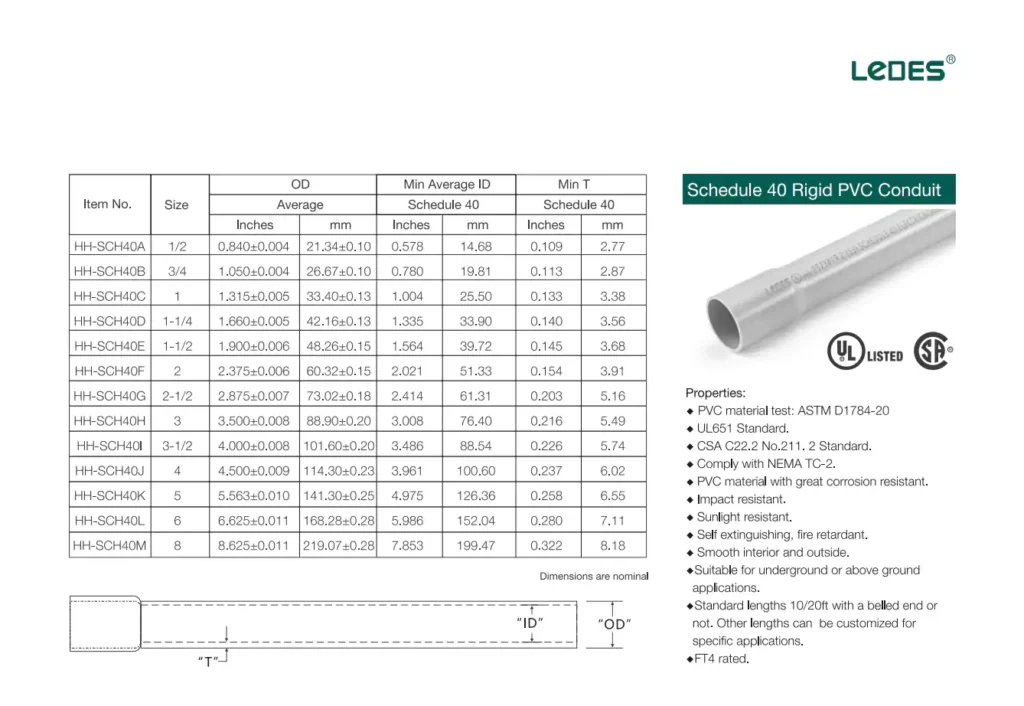
Conduíte do Anexo 40 Tamanho do comércio (EUA)
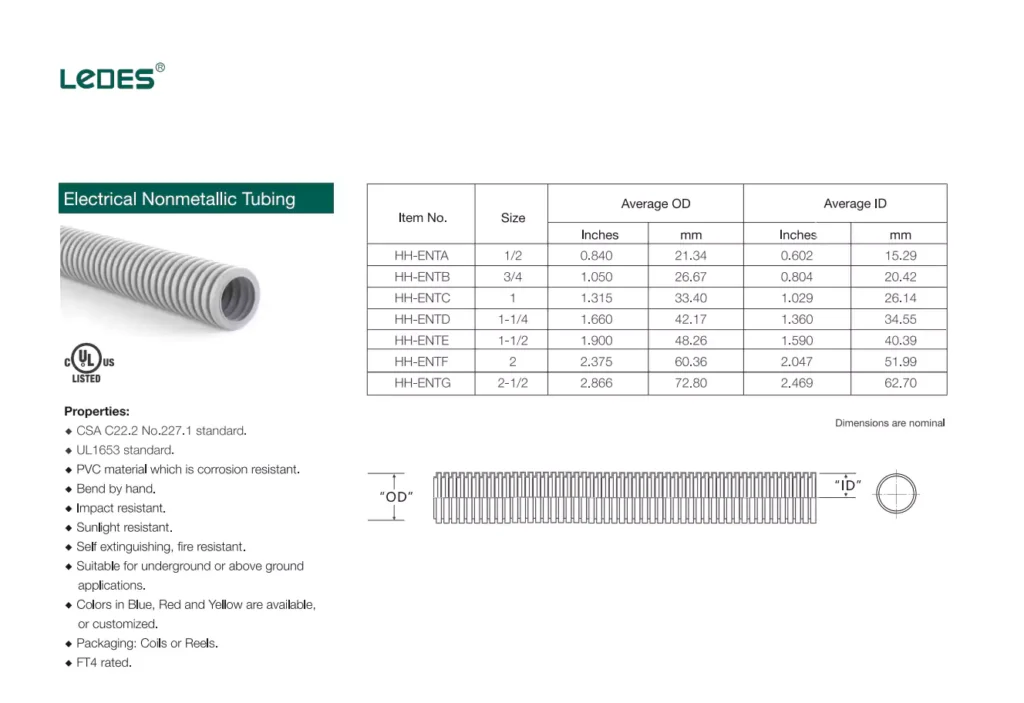
Conduíte ORL Tamanho do comércio (Canadá)
Conduíte subdimensionado: Pode resultar em superaquecimento, danos ao isolamento e até mesmo incêndios devido ao acúmulo excessivo de calor. Isso representa um sério risco à segurança e pode levar a reparos caros ou acidentes.
Conduíte superdimensionado: Embora pareça melhor, isso pode levar a custos desnecessários de material, aumento de peso e possível interferência no design do veículo.
O Roadster da Tesla, conhecido por seu desempenho impressionante, usa sistemas de carregamento de alta potência que exigem fluxo de corrente substancial. Seus engenheiros selecionaram cuidadosamente conduítes com diâmetros apropriados para lidar com essas correntes exigentes sem comprometer a segurança ou a eficiência. O subdimensionamento teria prejudicado significativamente a velocidade de carregamento e representado um risco de incêndio.
“Escolher o tamanho certo do conduíte é como encontrar a peça perfeita de um quebra-cabeça”, explica John Smith, engenheiro elétrico líder na Automotive Wire Products Association (AWPA). “É sobre equilibrar a capacidade de corrente, bitola do fio, fatores ambientais e design geral do veículo para garantir desempenho e segurança ideais.”
Recursos de consultoria automotiva, como:
Código Elétrico Nacional (NEC):
Fornece diretrizes para instalações elétricas seguras em veículos.
Normas SAE:
Ofereça recomendações específicas para fiação automotiva e dimensionamento de conduítes.
Especificações do fabricante:
Consulte sempre as diretrizes do fabricante do seu veículo para obter requisitos precisos sobre conduítes.
Código local:
O conduíte de fio e o conduíte de PVC são muito próximos. Porque precisamos considerar não apenas o conduíte de fio do automóvel em si, mas também a instalação do conduíte de cabo e a proteção da estação de carregamento super rápido.
Vamos tomar a América do Norte como exemplo. O padrão atual UL 651 nos Estados Unidos (aplicável a Conduítes de PVC Rígidos), ou UL 1653 ou CSA C22.2 Os padrões NO. 227.1:19 para conduítes ENT são todas especificações que precisam ser seguidas. Ao mesmo tempo, a resistência ao fogo também é um fator que precisa ser focado. Então é muito necessário ter testes e certificações relacionados a UL94 V-0 ou FT4.
Ao entender os fatores que influenciam o tamanho do conduíte e aproveitar os padrões do setor, você pode garantir que seu sistema elétrico automotivo opere com segurança, eficiência e confiabilidade.
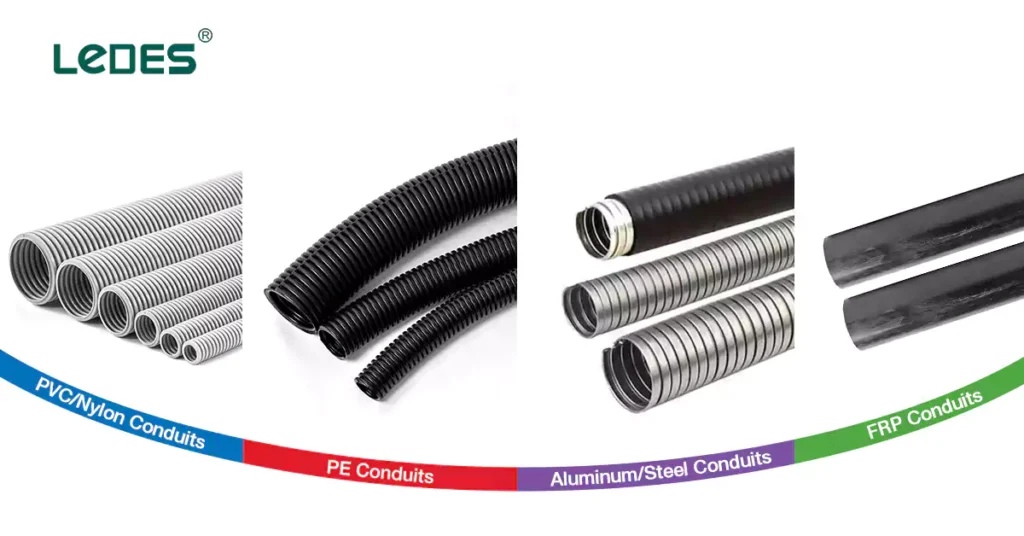
Sob o capô dos veículos modernos, uma rede complexa de sistemas elétricos zumbe com atividade, alimentada por conduítes especializados que transportam correntes vitais de forma segura e eficiente. Mas você sabia que esses heróis anônimos são feitos de uma gama diversificada de materiais, cada um com seus próprios pontos fortes e limitações?
Esses conduítes versáteis oferecem excelente flexibilidade, resistência a impactos e custo-benefício. Eles são amplamente usados para aplicações de baixa a média tensão em chicotes elétricos automotivos devido à sua facilidade de instalação e durabilidade.
Estudo de caso: Em restaurações de carros clássicos, Conduíte de PVC é frequentemente preferido por sua capacidade de imitar a estética original, ao mesmo tempo em que fornece isolamento confiável para componentes elétricos.
Os conduítes de PE ostentam alta flexibilidade, resistência química e excelentes propriedades dielétricas. Eles são particularmente adequados para aplicações automotivas que exigem durabilidade contra umidade e fatores ambientais.
Um relatório de 2021 da Grand View Research indica que o mercado global de polietileno deve atingir $255 bilhões até 2030, impulsionado em parte por seu amplo uso em diversos setores, incluindo o automotivo.
Embora mais pesados do que seus equivalentes termoplásticos, os conduítes metálicos oferecem condutividade elétrica superior e blindagem contra interferência eletromagnética (EMI). Eles são frequentemente usados em aplicações de alta tensão ou onde a proteção EMI é crítica, como em sistemas de bateria EV.
Estudo de caso:
O Model S Plaid da Tesla utiliza conduítes de alumínio para gerenciar as correntes significativas que fluem dentro de seu sistema de transmissão elétrico de alto desempenho, garantindo fornecimento de energia seguro e eficiente.
Os conduítes de FRP combinam resistência, propriedades leves e excelente resistência à corrosão, tornando-os ideais para aplicações expostas a ambientes agressivos ou que exigem longa vida útil.
“Para veículos elétricos operando em climas extremos ou condições off-road, os conduítes de FRP oferecem uma solução robusta que pode suportar fatores ambientais exigentes”, afirma David Lee, engenheiro de materiais do Automotive Innovation Center.
O futuro dos materiais de conduítes automotivos provavelmente verá:
Maior uso de materiais sustentáveis e reciclados.
Desenvolvimento de compósitos com melhores relações resistência-peso.
Integração de tecnologias de detecção inteligente para monitoramento e diagnóstico em tempo real.
Escolher o material certo para sua aplicação específica é crucial para garantir segurança, desempenho e longevidade. Entender as propriedades e aplicações de cada material capacitará você a tomar decisões informadas quando se trata da infraestrutura elétrica do seu veículo.
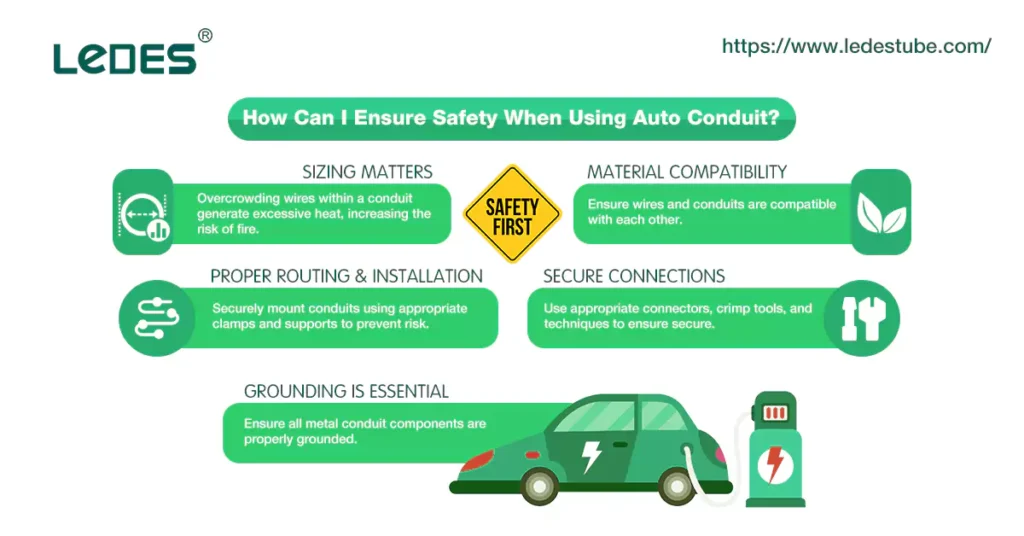
Os conduítes automotivos são os heróis anônimos do sistema elétrico do seu veículo, garantindo um fornecimento de energia seguro e eficiente. Mas, como qualquer componente vital, o manuseio ou instalação inadequados podem levar a consequências sérias.
Priorizar a segurança ao trabalhar com conduítes automotivos não é negociável. Aqui está uma análise das práticas essenciais:
Fios superlotados dentro de um conduíte geram calor excessivo, aumentando o risco de falha de isolamento e potenciais incêndios. Conduítes subdimensionados também podem levar a superaquecimento e danos.
De acordo com a National Fire Protection Association (NFPA), problemas elétricos são responsáveis por cerca de 46.000 incêndios estruturais residenciais anualmente nos EUA, destacando a importância do dimensionamento adequado.
Certifique-se de que os fios e conduítes sejam compatíveis entre si, considerando fatores como classificação de voltagem, resistência à temperatura e compatibilidade química.
Uma instalação defeituosa envolvendo materiais de conduíte incompatíveis levou à quebra do isolamento no sistema de fiação de um carro clássico, resultando em incêndio durante a operação. Sempre consulte as especificações do fabricante para diretrizes de compatibilidade.
Use conectores, ferramentas de crimpagem e técnicas apropriadas para garantir conexões seguras e resistentes à vibração dentro do conduíte. Conexões frouxas podem levar a arcos, curtos ou até mesmo falha completa do circuito.
Padrão da indústria: O SAE (Sociedade de Engenheiros Automotivos) fornece padrões detalhados para projeto de conectores elétricos e práticas de instalação em veículos.
Passe os conduítes longe de fontes de calor, bordas afiadas e áreas sujeitas a vibração excessiva. Monte os conduítes com segurança usando grampos e suportes apropriados para evitar movimento e possíveis danos aos fios.
Certifique-se de que todos os componentes do conduíte metálico estejam devidamente aterrados para fornecer um caminho seguro para correntes de falha, minimizando o risco de choque elétrico ou ferimentos.
“A segurança deve ser sempre primordial ao trabalhar com conduítes automotivos”, enfatiza Mary Johnson, engenheira elétrica líder do Automotive Safety Institute. “Aderir aos padrões da indústria, usar materiais e técnicas apropriados e priorizar conexões seguras são etapas cruciais para prevenir riscos potenciais.”
Inspecione regularmente o sistema de conduítes do seu veículo em busca de sinais de desgaste, danos ou conexões soltas.
Consulte um eletricista qualificado para qualquer reparo complexo de fiação ou conduíte.
Ao aderir a essas práticas de segurança, você pode garantir que seus conduítes automotivos funcionem de forma confiável e proteger seu veículo e você mesmo de riscos elétricos. Lembre-se: a segurança não é apenas uma prioridade, é a base de uma experiência de direção segura e agradável.
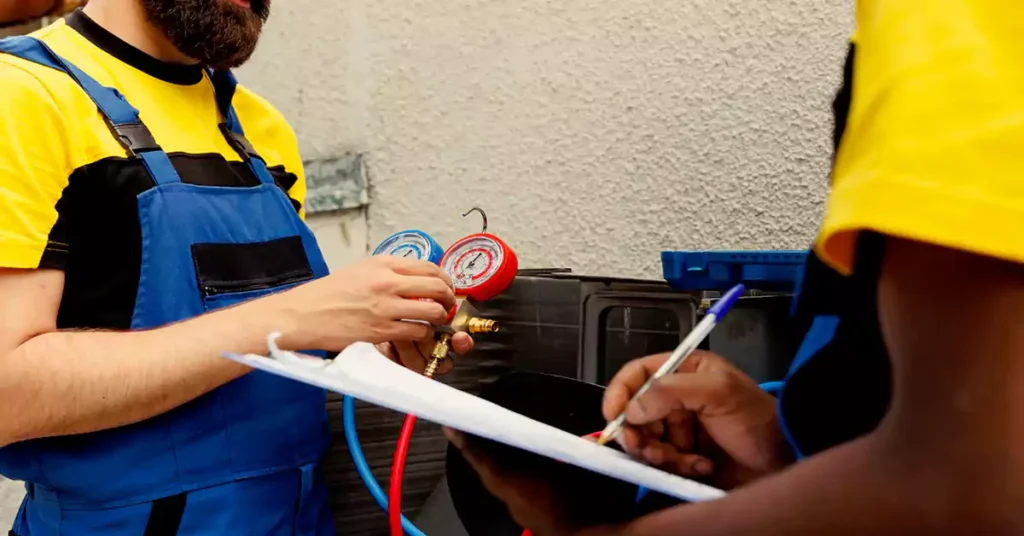
Pense no seu sistema de conduíte automotivo como o herói anônimo da infraestrutura elétrica do seu veículo. Embora muitas vezes escondido sob o capô, ele desempenha um papel vital no fornecimento seguro de energia para cada componente. Assim como qualquer sistema crítico, a manutenção regular garante desempenho e longevidade ideais.
Negligenciar seu sistema de conduítes pode levar a superaquecimento, curto-circuitos, mau funcionamento e até incêndios – consequências que nenhum motorista quer enfrentar. Veja como manter seus conduítes automotivos funcionando perfeitamente:
Inspecione regularmente os conduítes para sinais de desgaste, danos (rachaduras, cortes, abrasões), conexões soltas ou acúmulo excessivo de calor. A detecção precoce é crucial para evitar problemas sérios no futuro.
Estudo de caso: Um relatório de 2019 da Administração Nacional de Segurança no Tráfego Rodoviário (NHTSA) destacou que um chicote elétrico desfiado, levando a fios expostos dentro de um conduíte, foi um fator contribuinte para um incidente de incêndio em veículo.
Examine os conectores para verificar se há corrosão, folga ou sinais de superaquecimento. Aperte firmemente quaisquer conexões soltas e substitua os conectores danificados conforme necessário.
Padrão da indústria: A SAE (Society of Automotive Engineers) fornece diretrizes específicas para práticas de instalação e manutenção de conectores para garantir conexões seguras e confiáveis.
Inspecione os conduítes para áreas onde eles roçam em bordas afiadas, peças móveis ou outros componentes. Use mangas protetoras, acolchoamento ou ajuste o roteamento para minimizar o atrito e evitar danos ao isolamento.
Um estudo da Sociedade de Engenheiros Automotivos (SAE) descobriu que o roteamento incorreto de conduítes era uma causa comum de falhas na fiação dos veículos, levando a problemas elétricos e potenciais riscos à segurança.
Calor excessivo pode degradar materiais de conduíte e isolamento. Verifique se há sinais de superaquecimento perto de componentes de alta corrente ou em áreas com ventilação ruim.
Perspectiva do especialista:
“Verificar regularmente as flutuações de temperatura ao redor dos conduítes é essencial”, afirma a Dra. Emily Chen, Engenheira de Materiais Líder da Automotive Industry Association (AIA). “Altas temperaturas podem impactar significativamente a vida útil do material e levar a falhas prematuras.”
Para reparos complexos, solução de problemas elétricos ou se você não tiver certeza sobre qualquer aspecto da manutenção de conduítes, consulte um eletricista qualificado, especializado em sistemas automotivos.
A manutenção proativa economiza no futuro:
Ao incorporar essas práticas à sua rotina de cuidados com o veículo, você pode evitar reparos caros, garantir uma operação segura e prolongar a vida útil do seu sistema de conduíte automotivo. Lembre-se: um pouco de cuidado preventivo faz toda a diferença para manter seu passeio funcionando sem problemas e com segurança.
O sistema de conduíte automático do seu veículo atua como o guardião silencioso da rede elétrica, canalizando energia de forma segura e eficiente. Mas, como qualquer sistema complexo, às vezes ele pode encontrar problemas. Saber como solucionar esses problemas pode lhe poupar dores de cabeça, custos de reparo e até mesmo perigos potenciais.
Aqui está seu roteiro para diagnosticar e resolver problemas comuns de conduítes automotivos:
O primeiro passo é reconhecer os sinais. Procure por luzes piscando, fusíveis queimados, mau funcionamento de componentes elétricos ou ruídos incomuns (zumbidos, estalos) perto dos conduítes.
Um estudo da AAA descobriu que problemas de fiação e sistemas elétricos defeituosos são responsáveis por mais de 20% de solicitações de reparo de veículos anualmente, destacando a prevalência de problemas relacionados a conduítes.
Examine cuidadosamente os conduítes em busca de rachaduras, cortes, conexões soltas, atrito ou sinais de superaquecimento.
Estudo de caso: Um cliente relatou luzes de advertência intermitentes no painel e um vidro elétrico com defeito. Após a inspeção, um técnico descobriu uma mordida de roedor em um conduíte automotivo perto do compartimento do motor, interrompendo o fluxo elétrico.
Inspecione os conectores para verificar se há corrosão, fios soltos ou danos aos pinos. Use um multímetro para testar a continuidade da voltagem em cada ponto de conexão.
Padrão da indústria: A SAE (Sociedade de Engenheiros Automotivos) fornece diretrizes detalhadas para procedimentos de inspeção e teste de conectores em seus padrões de fiação automotiva.
Certifique-se de que todos os componentes do conduíte de metal estejam firmemente aterrados usando uma tira ou parafuso de aterramento. Use um multímetro para verificar a continuidade do aterramento colocando uma sonda no conduíte e a outra em um ponto de aterramento conhecido.
Perspectiva do especialista:
“O aterramento adequado é crucial para a segurança”, explica John Smith, engenheiro elétrico líder do Automotive Safety Institute. “Uma conexão de aterramento defeituosa pode levar a choques elétricos ou até mesmo danos a componentes eletrônicos.”
Inspecione cuidadosamente o chicote elétrico dentro do conduíte para ver se há fios quebrados, isolamento desfiado ou fios comprimidos. Substitua quaisquer seções danificadas do chicote.
Para problemas complexos ou se você não se sentir confortável em diagnosticar e consertar problemas elétricos sozinho, consulte um eletricista automotivo qualificado. Eles têm a experiência e as ferramentas para identificar o problema com precisão e garantir um reparo seguro.
Seguindo essas etapas de solução de problemas, você pode ficar mais confiante para lidar com problemas comuns de conduítes automotivos. Lembre-se, uma ação rápida evita que problemas menores se transformem em grandes dores de cabeça e potenciais riscos à segurança.
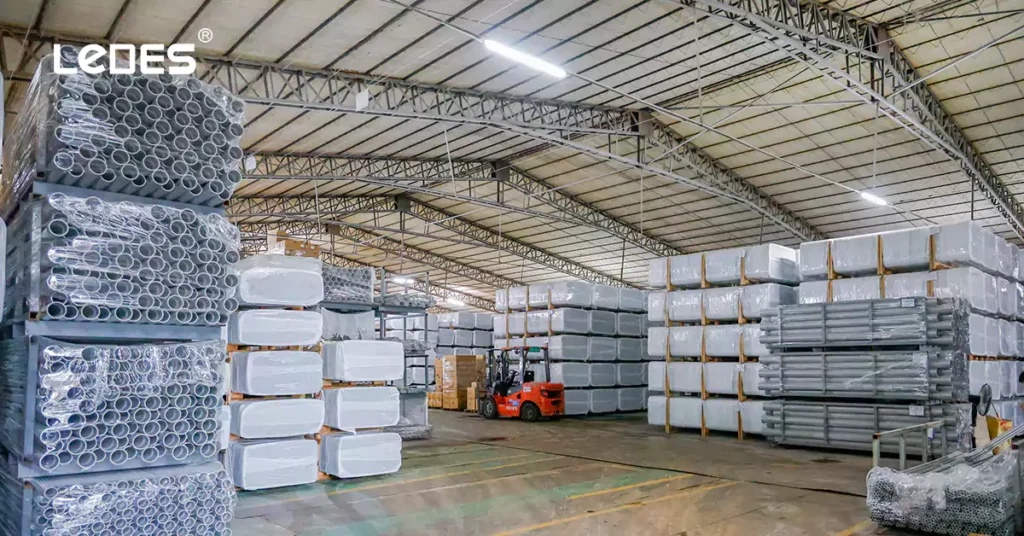
Quando se trata do sistema elétrico do seu veículo, a confiabilidade é primordial. Selecionar o certo fornecedor de conduítes elétricos automotivos pode fazer toda a diferença entre um motor funcionando perfeitamente e um possível cenário de pesadelo.
Veja como navegar no mercado e encontrar um fornecedor digno de sua confiança:
Procure fornecedores com histórico comprovado na indústria automotiva. Anos de experiência se traduzem em profundo entendimento das propriedades dos materiais, requisitos específicos da aplicação e padrões da indústria em evolução.
Estudo de caso: Uma renomada equipe de automobilismo mudou para um novo fornecedor de conduítes para seus veículos de corrida. A mudança resultou em melhor condutividade e resistência superior à temperatura, contribuindo para um aumento significativo de desempenho durante eventos competitivos.
Garantia de demanda: solicite certificações como ISO 9001 (Gestão da qualidade), AS9100 (Aeroespacial) ou padrões automotivos específicos da indústria. Elas demonstram comprometimento com o controle de qualidade e integridade do material.
Um relatório da American Automotive Association (AAA) destacou que o uso de materiais não conformes em reparos de veículos pode levar a mau funcionamento, riscos à segurança e reparos caros no futuro.
Avalie se o fornecedor oferece uma gama diversificada de tipos de conduítes (PVC, náilon, metal, etc.) e tamanhos para atender às suas necessidades específicas.
Perspectiva do especialista:
“Um fornecedor respeitável entenderá que um tamanho não serve para todos”, diz Sarah Johnson, engenheira-chefe da Auto Wire Solutions. “Eles devem oferecer opções de personalização para aplicações e modelos de veículos exclusivos.”
Procure fornecedores que ofereçam atendimento rápido ao cliente, suporte técnico e recursos prontamente disponíveis (por exemplo, guias de aplicação, manuais de instalação).
Estudo de caso: Uma pequena oficina elogiou um fornecedor específico de conduítes para fiação automotiva por sua assistência técnica excepcional na solução de problemas de fiação complexos, o que acabou economizando tempo e recursos valiosos.
Compare orçamentos de vários fornecedores, considerando o valor geral, não apenas o menor preço. Considere os prazos de entrega, opções de entrega e potenciais descontos em grandes quantidades.
Escolher um fornecedor confiável de conduítes automotivos é um investimento no desempenho e na segurança do seu veículo. Ao priorizar experiência, qualidade, suporte e personalização, você se prepara para o sucesso e confiabilidade duradoura na estrada à frente.
A indústria automotiva está à beira de uma revolução, impulsionada pela eletrificação, direção autônoma e conectividade avançada. Essa rápida evolução exige uma transformação em todos os aspectos do design de veículos, incluindo o mundo frequentemente negligenciado dos conduítes de fiação.
Aqui está uma espiada no futuro emocionante dos conduítes automotivos:
À medida que os veículos buscam maior eficiência de combustível e alcance (especialmente em veículos elétricos), materiais leves como compostos de fibra de carbono, plásticos reforçados com fibra de vidro (FRP) e até mesmo polímeros avançados se tornarão cada vez mais predominantes.
Estudo de caso: O Model S Plaid da Tesla utiliza uma combinação de alumínio e materiais compostos em seus chicotes elétricos, reduzindo significativamente o peso sem comprometer a resistência ou a condutividade.
Um relatório de 2023 da Grand View Research projeta que o mercado global de sensores automotivos atingirá $169 bilhões até 2030, destacando a crescente integração de tecnologias de detecção em veículos.
Integração de Sensores: Conduítes futuros podem incorporar sensores embutidos para monitoramento em tempo real de temperatura, pressão, vibração e até mesmo fluxo de corrente elétrica. Esses dados podem ajudar a prever falhas potenciais, otimizar o desempenho e permitir manutenção proativa.
Imagine um autoconduíte que pode reparar pequenos danos de forma autônoma! A pesquisa em materiais auto-reparadores está progredindo rapidamente, oferecendo o potencial para maior durabilidade e vida útil estendida.
Perspectiva do especialista:
“O futuro dos conduítes automotivos está na integração inteligente”, diz a Dra. Emily Chen, Engenheira de Materiais Líder da Automotive Industry Association (AIA). “Os recursos de autocorreção podem revolucionar os procedimentos de manutenção e melhorar significativamente a segurança.”
O carregamento sem fio já está se tornando comum em smartphones e outros dispositivos. Essa tecnologia tem imenso potencial para veículos, eliminando a necessidade de conexões físicas entre a bateria e os componentes elétricos, reduzindo a desordem de cabos e melhorando a eficiência geral.
Estudo de caso: Empresas como a Local Motors já estão explorando a impressão 3D para criar conduítes personalizados sob medida para modelos de veículos específicos e requisitos de aplicação. Isso abre portas para maior flexibilidade de design e fabricação sob demanda.
O futuro dos conduítes automotivos promete uma mudança dinâmica em direção a sistemas mais inteligentes, leves e resilientes, contribuindo, em última análise, para veículos mais seguros, eficientes e tecnologicamente avançados.
Graças ao rápido desenvolvimento dos veículos elétricos, os condutores automotivos passaram de uma série de condutores despercebida para o rápido desenvolvimento atual.
Ele funciona em ambientes severos por um longo tempo, então seu desempenho é muito importante. Atualmente, a AAA também estabeleceu padrões relevantes. Neste artigo, também mencionamos como escolher o conduíte elétrico automotivo certo, e tipo, material, etc., e como mantê-lo durante o uso.
Isso é tudo para este post. Se você ainda tiver dúvidas, pode enviar um formulário ou um e-mail para nossos especialistas, que discutirão soluções específicas com você.



